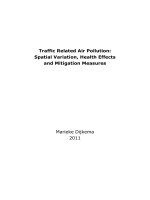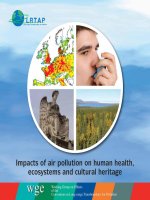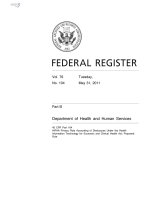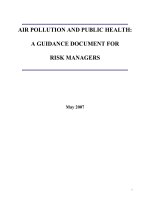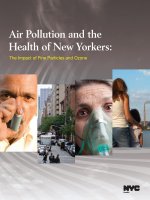Cross-State Air Pollution Rule: Reducing Air Pollution Protecting Public Health potx
Bạn đang xem bản rút gọn của tài liệu. Xem và tải ngay bản đầy đủ của tài liệu tại đây (3.05 MB, 27 trang )
Cross-State Air Pollution Rule
Reducing Air Pollution
Protecting Public Health
U.S. Environmental Protection Agency
Office of Air and Radiation
Overview of Action
• EPA finalized the Cross-State Air Pollution Rule (CSAPR) under the “good
neighbor” provision of the Clean Air Act to reduce transported pollution that
significantly affects downwind nonattainment and maintenance problems.
• CSAPR will reduce emissions of SO
2
and NO
X
from power plants in the eastern
half of the United States.
• The rule will reduce fine particle and ozone air pollution, saving lives, preventing
illnesses, creating jobs, and protecting communities.
• The costs are affordable, and greatly outweighed by the benefits:
– The $800 million spent annually on this rule in 2014, along with the roughly $1.6 billion per year in
capital investments already under way as a result of the Clean Air Interstate Rule (CAIR), are
improving air quality for over 240 million Americans and will result in $120 to $280 billion in annual
benefits.
– The effect on electricity prices for specific regions or states are well within the range of normal price
fluctuations.
• The rule puts in place a new framework to address pollution that affects air
quality in downwind states:
– Helps states meet air quality standards as quickly as possible.
– Similar to previous allowance trading programs, the rule encourages innovation and cost-savings
and helps power plants achieve their mission of providing clean, affordable, and reliable energy.
2
Cross-State Air Pollution
Rule States
3
Key Dates
– October 17, 2011: Deadline to notify EPA if a state wants to replace
2013 FIP allocations with state allocations.
• As of this deadline, twelve states notified EPA that they intended to distribute
2013 CSAPR allowances to sources in their states.
– January 1, 2012: Cross-State Air Pollution Rule Phase 1 SO
2
and
annual NO
X
trading programs begin.
• Sources must demonstrate compliance by March 1, 2013.
– May 1, 2012: Cross-State Air Pollution Rule ozone season NO
X
trading program begins.
• Sources must demonstrate compliance by December 1, 2012.
• Ozone season ends September 30.
– January 1, 2014: Phase 2 SO
2
and annual NO
X
trading programs
begin.
• Sources must demonstrate compliance by March 1, 2015.
– May 1, 2014: Cross-State Air Pollution Rule Phase 2 ozone season
NO
X
trading program begins.
• Sources must demonstrate compliance by December 1, 2014.
4
Transition to CSAPR
• CAIR will be implemented through 2011 compliance periods.
• CSAPR covers emissions in 2012 and beyond.
• CSAPR establishes new allowances for all programs.
– There is no carryover of Acid Rain Program, NO
X
SIP Call/NO
X
Budget Trading Program (NBP), or CAIR allowances.
• To comply with the rule, EPA anticipates power plants will:
– Improve efficiency at existing sources
– Improve performance of existing SO
2
and NO
X
pollution control
equipment
– Use previously planned or constructed clean generating sources
– Load shift to existing cleaner units
– Use lower sulfur coal, switch fuels
– Install or upgrade pollution control equipment, such as low NO
X
burners or scrubbers (Flue Gas Desulfurization) over time
– Buy allowances
5
States Investing in Pollution Control
Will See Large Benefits
6
Cross-State Air Pollution Rule RIA, Table 1-1 and 1-2; mortality impacts estimated using Laden et al.
(2006), Levy et al. (2006), Pope et al. (2002) and Bell et al. (2004); monetized benefits discounted at 3%
Mortality Avoided
Monetized Benefits (billion $)
Low
High
Low
High
0 to 400
0 to 1,000
0 to 3.3
0 to 8
400 to 800
1,000 to 2,000
3.3 to 7
8 to 17
800 to 1,300
2,000 to 3,300
7 to 11
17 to 27
The public health benefits in most states exceed
the combined annual costs of implementing the
Cross-State Air Pollution Rule for the entire region.
State-Level Benefits in 2014
• EPA estimates the annual benefits
from the rule range between $120-
$280 billion (2007 $) in 2014.
• Much of the annual benefit results
from the prevention of 13,000 to
34,000 premature mortalities.
Scale: Largest bar equals 2.2 million
tons of SO
2
emissions in Ohio, 1990
Source: EPA, 2011
* Emissions shown include only Acid Rain Program sources; these sources include 96%
of modeled annual SO
2
emissions and 71% of modeled units in 2014.
Total U.S. Emissions
Annual SO
2
Power Plant Emissions
1990-2014 *
7
Scale: Largest bar equals 534 thousand
tons of NO
X
emissions in Ohio, 1990
Source: EPA, 2011
* Emissions shown include only Acid Rain Program sources; these sources include 94%
of modeled annual NO
X
emissions and 71% of modeled units in 2014.
Total U.S. Emissions
Annual NO
X
Power Plant Emissions
1990-2014 *
8
Scale: Largest bar equals 216 thousand tons of
ozone season NO
X
emissions in Ohio, 1997
Source: EPA, 2011
* Projected emissions are taken from the final CSAPR modeling as of July 6, 2011, which included the six states proposed for inclusion in the ozone season NO
X
program. While December’s final
supplemental rule included revisions that are not reflected in this map, the changes overall amount to only a small proportion of the millions of tons of pollution reduction secured by the CSAPR.
Emissions shown include only Acid Rain Program sources; these sources include 94% of modeled ozone season NO
X
emissions and 71% of modeled units in 2014.
Total U.S. Emissions
Ozone Season NO
X
Power Plant
Emissions 1997-2014 *
9
2000 Coal Controls for SO
2
and
NO
X
Source: National Electric Energy Data System (NEEDS
4.10) (EPA, December 2010) and Data & Maps (EPA,
August 2011)
Virtually all coal-fired units have electrostatic
precipitators, baghouses, or other advanced
controls for high levels of particulate
removal.
10
2010 Coal Controls for SO
2
and NO
X
Virtually all coal-fired units have electrostatic
precipitators, baghouses, or other advanced
controls for high levels of particulate
removal.
Source: National Electric Energy Data System (NEEDS
4.10) (EPA, December 2010) and Data & Maps (EPA,
August 2011)
11
2014 Coal Controls for SO
2
and NO
X
Source: National Electric Energy Data System (NEEDS
4.10) (EPA, December 2010) and Data & Maps (EPA,
August 2011)
Dry Sorbent Injection (DSI) is included as a
scrubber for the purpose of this map.
Virtually all coal-fired units have electrostatic
precipitators, baghouses, or other advanced
controls for high levels of particulate
removal.
12
Supplemental Notice of
Final Rulemaking
• On December 15, 2011, EPA finalized a supplemental rulemaking
to require the following five states to make summertime NO
X
reductions under the CSAPR ozone-season control program:
– Iowa
– Michigan
– Missouri
– Oklahoma
– Wisconsin
• EPA has concluded that these five states plus Kansas significantly
contribute to nonattainment and/or interference with maintenance
of the 1997 ozone National Ambient Air Quality Standard
(NAAQS) in other states.
– However, EPA is not taking action on the inclusion of Kansas in the
ozone season NO
X
program at this time due to the unique status of
Kansas' state implementation plan for ozone.
• EPA is finalizing the ozone season NO
X
program as federal
implementation plans for IA, MI, MO, OK, WI.
13
CSAPR Proposed
Revisions
• On October 6, EPA proposed technical revisions to 9 state
budgets.
• Proposal does not change basic CSAPR approach.
• Proposed revisions will not affect the CSAPR air quality
improvements or impact CSAPR’s goal to reduce interstate
transport of pollution to help downwind states.
• Proposed revisions include:
– Revisions to state budgets for FL, LA, MI, MS, NE, NJ, NY, TX, WI.
– Recalculation of the New Unit Set Asides for TX and AR.
– Limitations on allowances to units covered by existing consent
decrees in some states – AL, IN, KS, KY, OH, TN.
– Revision of assurance provisions effective date.
– Establishes a deadline for stakeholder input on unit corrections.
14
Budgets under CSAPR
and CAIR
Comparison of combined emission budgets for states covered by both CSAPR and CAIR
(million tons)
Initial Phase
CAIR Budgets
CSAPR Budgets
Annual SO
2
3.25
3.24
Annual NO
X
1.33
1.16
Ozone Season NO
X
0.56
0.49
Sources: CAIR preamble pages 25329, 25320, and 25323-25324 ( CSAPR
preamble tables VI.F–1, VI.F–2, VI.F–3 ( CSAPR SNPR tables I.C–1
and I.C–2 (
• CAIR began covering NO
X
emissions in 2009 and SO
2
emissions in 2010.
• CSAPR applies to emissions in 2012 and beyond.
• The initial phase for CSAPR compliance begins in 2012 for all programs.
• Sources covered by the CSAPR annual NO
X
and SO
2
programs must comply – that is,
surrender allowances to cover their 2012 annual emissions – in March 2013.
• Sources covered by the NO
X
ozone season program must comply on December 1,
2012 by surrendering allowances sufficient to cover 2012 ozone season NO
X
emissions.
15
• Many emission reductions within the CSAPR region
are already slated to occur.
• Based on 2010 emission data, many CSAPR states,
due in large part to the CAIR requirements that are
to be replaced by CSAPR, are already emitting at
levels that are below or close to their 2012 CSAPR
budgets.
• SO
2
emissions from CSAPR states fell by 8% from
2010 levels over the first nine months of 2011.
16
Clear Progress Toward 2012
CSAPR Requirements
Allowance Market
Progress
• Viable markets are emerging due to existing trading program
infrastructure and sound market fundamentals.
– The final rule maintains the flexibility of trading and builds on a highly successful
market-based approach familiar to the power sector over the past 15 years.
• The data reporting and tracking systems for emissions and allowance
data provide a high degree of transparency, allowing market participants
unprecedented levels of information for decision-making.
• Allowance trading has already begun in CSAPR markets.
– On October 18, 2011, EPA placed 2012 allowances for all four CSAPR programs
into accounts for sources with a certified account Designated Representative
– Trades took place even before allowances were formally recorded.
– EPA has recorded allowance transfers between sources.
– Initial trades show prices decreasing rapidly as price exploration continues.
– CSAPR market following normal pattern – prices are initially high and then drop
rapidly as parties become familiar with market characteristics.
• Recent market prices are near or below prices forecast in EPA’s final
CSAPR analysis.
17
Moving Program
Forward…
• Outreach
– Presentations, meetings…
– Website -
• Key documents
• Regularly updated Q&As
– Training for states
• Series of topical webinars for states
(
• EPA Region 7 hosted a CSAPR implementation training in November
2011
– Assisting States with CSAPR Implementation
• Q & A on Non-EGUs (developed with OAQPS)
• Title V Permit Template (final by December/January)
• Model Rules for SIPs for 2014-beyond (final by January 2012)
• Finalizing Proposed Revisions
18
For more information, visit the CSAPR
website:
19
APPENDIX
20
